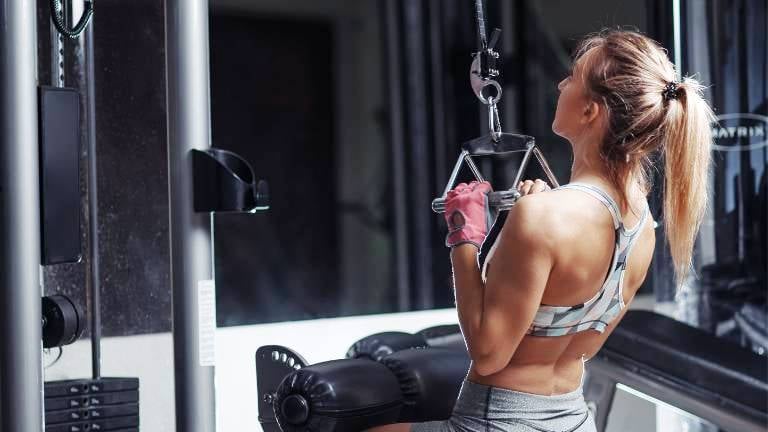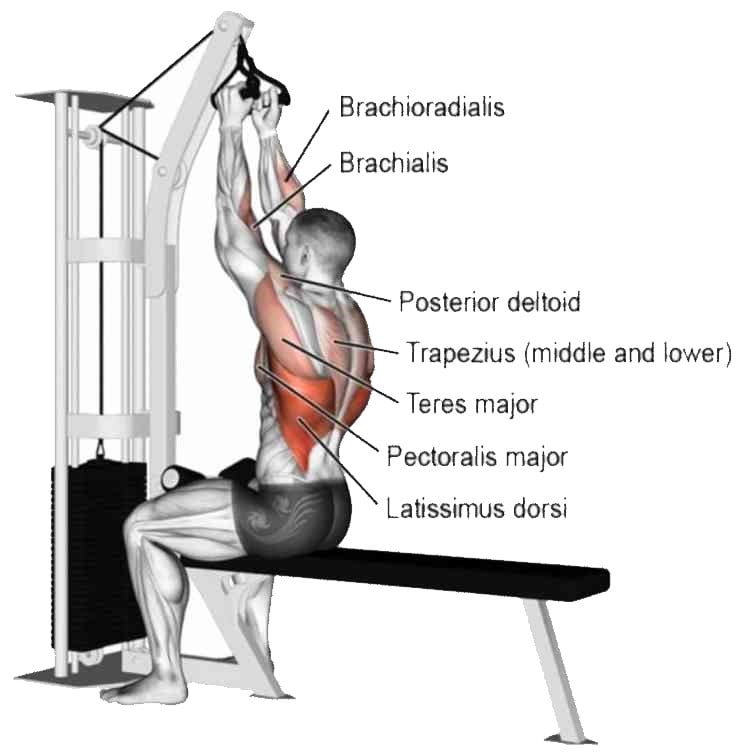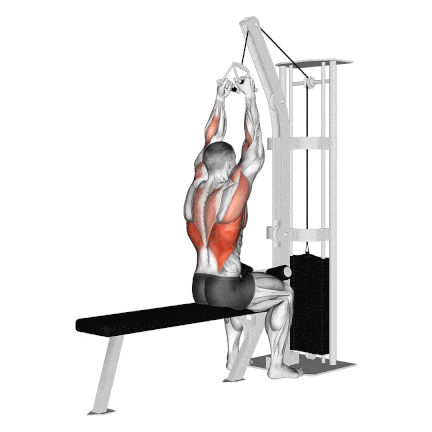The V-bar Lat Pulldown is one of the best variation of the Lat pulldown exercise that targets the back muscles (the latissimus dorsi). Bodybuilders and powerlifters often use it to build strength and muscle mass in the back.
In a standard lat pulldown, you use a wide or shoulder-width grip on a straight horizontal bar, but for a V-bar lat pulldown, you use a V-bar attachment that allows you to use a close, neutral grip.
The neutral grip puts less strain on the shoulder joints than a wide or overhand grip and allows you to lift heavy weights.
V-Bar lat pulldown helps you build a more balanced upper body. It is suitable for both beginners and advanced gym-goers who are looking to diversify their back workouts.

V Bar Lat Pulldown Muscles Worked
The V-bar lat pulldown is a compound exercise that simultaneously works for multiple muscle groups.
- Primarily Muscles Worked: Back muscles, specifically the latissimus dorsi.
- Secondary and Stabilizing muscles worked: Biceps and rhomboids, middle and lower trapezius, the brachialis, and brachioradialis.

How To Do Lat Pulldown With V Bar
- Attach the V-bar to the cable pulley on the lat pulldown machine.
- Adjust the thigh pads on the lat pulldown machine to ensure your legs are securely restrained.
- Sit down and grasp the V-bar with a neutral grip (palms facing each other).
- Keep your core engaged, chest up, and shoulders back.
- Lean your torso back slightly, finding the best angle that will allow you to maximally engage your latissimus dorsi muscles during the exercise.
- Keep your arms close to your body and pull the bar down toward your upper chest.
- Concentrate on squeezing your shoulder blades together as the V-bar gets closer to your chest.
- Pause briefly in the maximum contraction position, then slowly return to the starting position.

Form And Techniques
- Avoid excessively leaning back can disengage the latissimus dorsi and put unnecessary strain on your lower back. Maintain an upright posture, leaning slightly back, just enough to prevent the bar from hitting your face.
- Use controlled, steady movement both while pulling the bar down and releasing it back up. Jerking the weight down with body momentum reduces the exercise’s effectiveness and increases the risk of injury.
- Ensure you fully extend your arms at the starting position and pull the bar down at the upper chest level. Additionally, focus on squeezing the shoulder blades together at the bottom of the movement.
- You should keep your elbows pointing downward and to the rear. Flaring the elbows too far out or dragging them too far back can reduce lat engagement and put stress on the shoulders.
- Focus on pulling your elbows to your sides and behind your back, rather than cranking your arms closed. Studies show that this will help you to increase lat activation.
- A slight body sway is acceptable throughout the movement, but don’t make the common mistake of loading the machine with a huge load and lifting the stack with sloppy technique and partial range of motion
- Take a deep breath in as you extend your arms to the starting position. Breathe out as you pull the bar down to your chest. Breathe in again as you release the bar to the starting position.
- Recommended Sets and Reps: Beginners: 3 sets of 10–12 reps, Intermediate: 4 sets of 8–10 reps, and Advanced: 5 sets of 6–8 reps
V-Bar Lat Pulldown Vs Wide-Grip Lat Pulldown
The V-Bar Lat Pulldown and the Wide-Grip Lat Pulldown are both effective exercises for targeting the back, but they do so in slightly different ways. Here’s a quick comparison:
| Exercise | V-Bar Lat Pulldown | Wide-Grip Lat Pulldown |
|---|---|---|
| Grip | Utilizes a close, neutral grip on a V-shaped bar. | Uses a wide overhand grip on a straight bar. |
| Muscle Focus | Targets the lower part of the lats more directly. | It may be stressful for individuals with shoulder issues. |
| Secondary Muscles | Engages more of the biceps and lower traps. | Engages the teres major and rhomboids more significantly. |
| Joint Stress | It targets the upper part of the lats and broadens the back. | May be stressful for individuals with shoulder issues. |
| Range of Motion | Allows for a more extended range of motion in the downward phase. | The wide grip may limit the range of motion during the exercise. |
Which One Should You Choose?
- Choose the V-bar variation to target the lower lat muscles and prefer easier joint movement.
- If your goal is to build a broader back and you have no shoulder discomfort, opt for the wide grip.
References
- Andersen, V., Fimland, M. S., Wiik, E., Skoglund, A., & Saeterbakken, A. H. (2014). Effects of grip width on muscle strength and activation in the lat pull-down. Journal of Strength and Conditioning Research, 28(4), 1135-1142. doi:10.1097/JSC.0000000000000232
- Lusk, S. J., Hale, B. D., & Russell, D. M. (2010). Grip width and forearm orientation effects on muscle activity during the lat pull-down. Journal of Strength and Conditioning Research, 24(7), 1895-1900.

Manish is a NASM-certified fitness and nutrition coach with over 10 years of experience in weight lifting and fat loss fitness coaching. He specializes in gym-based training and has a lot of knowledge about exercise, lifting technique, biomechanics, and more.
Through “Fit Life Regime,” he generously shares the insights he’s gained over a decade in the field. His goal is to equip others with the knowledge to start their own fitness journey.
